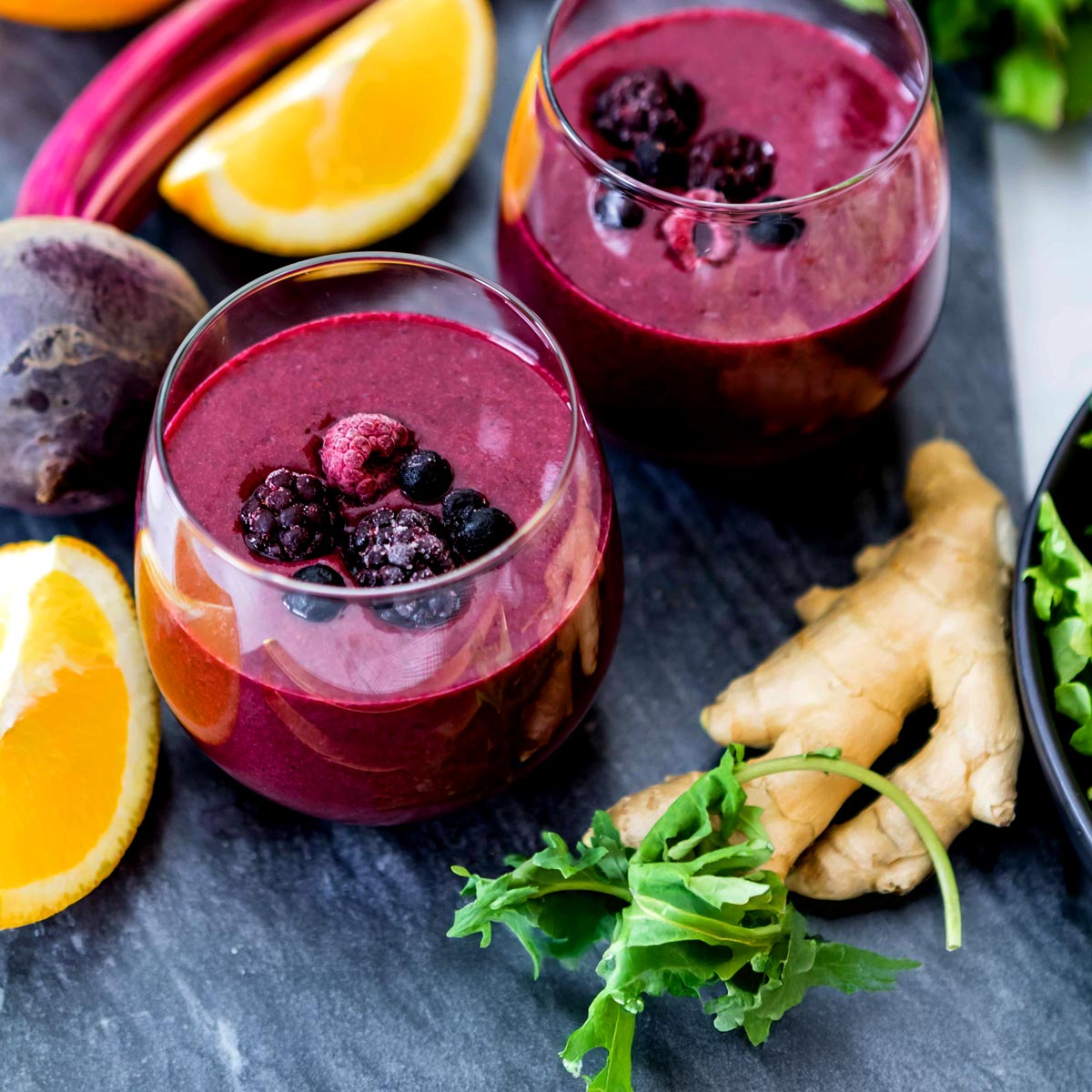
This post may contain affiliate links, meaning I can earn a small commission from items you purchase (at no cost to you).
Aging is wild. One day you’re doing handstands in the grass, the next you’re Googling “why does my knee sound like popcorn?” A lot of our aches and pains come down to inflammation—the bloating, brain fog, random rashes, and that lovely mid-afternoon crash. To combat it all, I created this anti-inflammatory smoothie recipe using plant-based ingredients that combat inflammation and are packed with nutrients.
Table of contents

Why You’ll Love It
- It tastes like a tropical treat. Earthy beets and kale get totally balanced out by sweet pineapple, mixed berries, and fresh orange—bright, tangy, and surprisingly smooth.
- It helps calm everyday inflammation. Each ingredient is chosen to support your joints, digestion, and energy—from ginger and berries to chia seeds and leafy greens.
- It’s a 5-minute reset. Perfect after a long run, a Costco marathon, or anytime your body needs a little extra love without any fuss.
- It’s nutrient-dense without being heavy. Fiber, antioxidants, and healthy fats come together in a refreshing, 16-oz blend your body will thank you for.
Save this Recipe for Later!
Enter your info below and I’ll send it straight to your inbox to save for later.
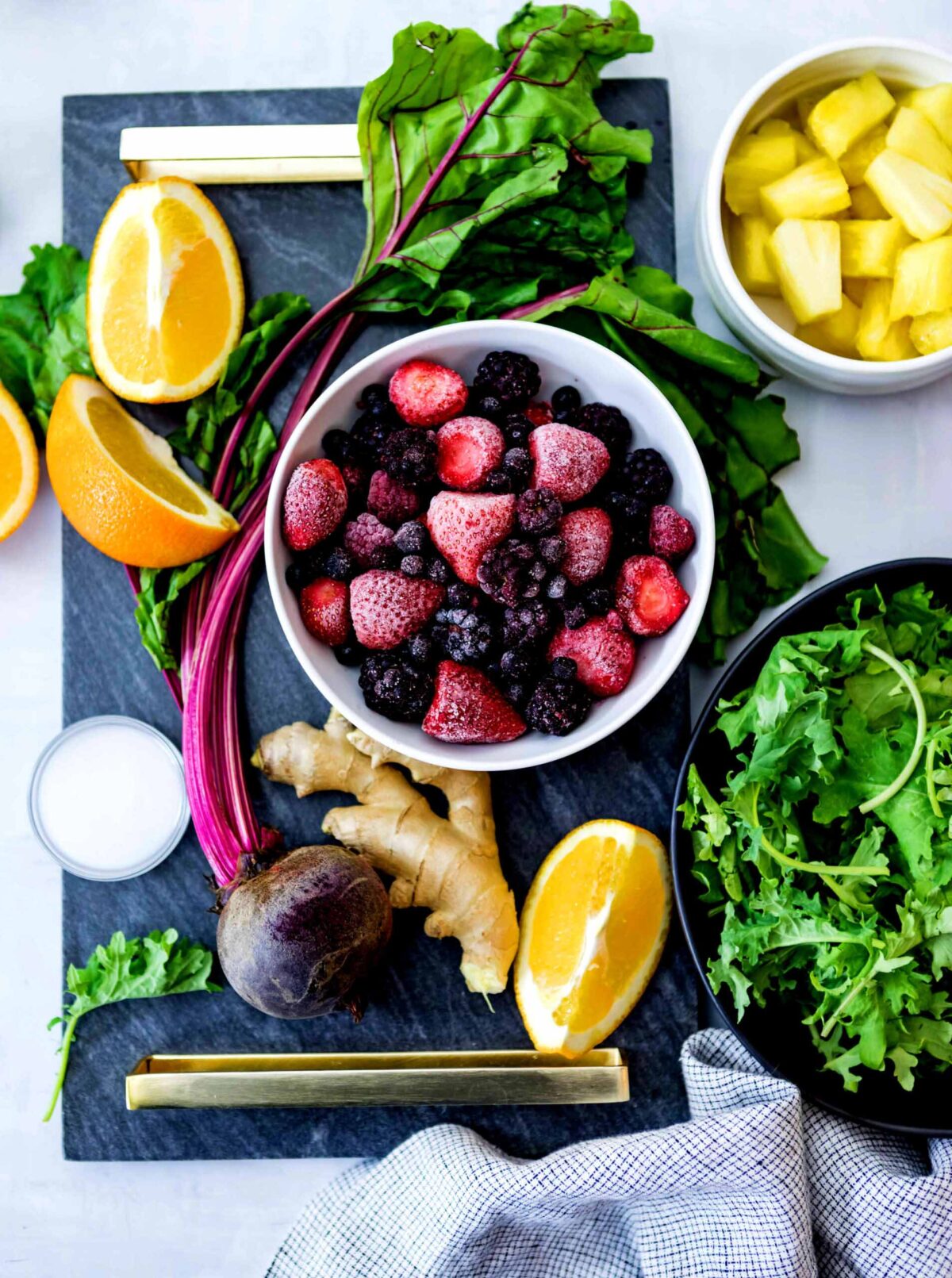
Ingredients You’ll Need
Sip on this smoothie with fresh beets, citrus fruits and anti-inflammatory ginger to recover from a Saturday morning shopping trip to Costco (never a good idea), a long run with your bestie or just another day living la vida loca. Here’s what goes into your glass, how each ingredient tastes and blends, plus the nutrition perks they bring to the party:
- Kale: Earthy and mildly grassy, kale makes a great base once blended properly. Blend it first with the water to avoid leafy bits. Kale is rich in antioxidants—especially flavonoids and vitamin C—which help reduce inflammation by neutralizing harmful free radicals.
- Beets: Sweet, earthy, and beautifully vibrant. Chop them small so your blender doesn’t struggle. Beets are loaded with betalains, powerful anti-inflammatory compounds that support heart health and may help lower blood pressure.
- Oranges: Bright, juicy, and naturally sweet, oranges add a silky texture and help balance the earthiness of the beets. Peel and remove seeds to avoid bitterness. Their vitamin C content helps reduce inflammation and boosts immune system by protecting cells from oxidative stress.
- Mixed Berries: Blueberries, blackberries, and raspberries bring tart, jammy sweetness and a thick, frosty texture. Their anthocyanins are some of the most powerful antioxidants around, helping reduce inflammation and protect against chronic diseases like heart disease and cancer.
- Pineapple: Tropical, sweet, and a little tangy, pineapple helps everything blend smoothly thanks to its juicy texture. It also contains bromelain, an enzyme known for its anti-inflammatory properties and its ability to support digestion—especially after physical stress or injury.
- Ginger Root: Warm, spicy, and bold in small amounts. Slice or grate it if you want a smoother finish. Ginger is packed with gingerols that provide strong anti-inflammatory effects and may help reduce muscle soreness and arthritis-related inflammation.
- Coconut Oil: Adds a light coconut flavor and a creamy finish. Melt slightly if solid so it blends seamlessly with the frozen fruit. Coconut oil contains lauric acid, a medium-chain fatty acid with anti-inflammatory and antimicrobial benefits that may support immune function.
- Chia Seeds: Mild, slightly nutty, and great for thickening your smoothie. Blend them in for smoothness or sprinkle on top for texture. Chia seeds are high in omega-3 fatty acids, which help reduce inflammation, support heart health, and add fiber and protein to keep you fuller longer.
Dietary Adjustments & Substitutions
Need to swap an ingredient or accommodate a food allergy? Click the button below for tailored suggestions just for you:
How to Make Anti-Inflammatory Smoothie
- Prep your produce. Wash and chop the kale and beets. Peel the orange and remove any seeds so it’s ready for the blender.
- Blend the base. Add the kale, chopped beets, peeled orange, and water to your blender. Blend on high until everything is completely smooth, scraping down the sides if needed.
- Add the fruit and flavor boosters. Toss in the frozen mixed berries, frozen pineapple, fresh ginger root, chia seeds, and coconut oil (if using).
- Blend until creamy. Blend again on high until the smoothie is thick, creamy, and no chunks remain. If it’s too thick, add a splash more water and blend again.
- Pour and enjoy. Pour into your favorite glass or jar. Garnish with extra chia seeds or a slice of orange if you’re feeling fancy, then sip right away for the biggest nutritional boost.
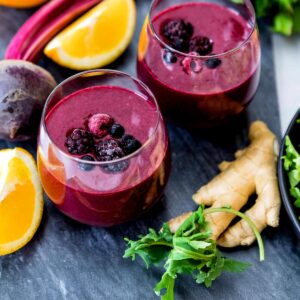
Anti-Inflammatory Smoothie
Ingredients
- ½ cup kale
- ½ cup beets peeled and chopped
- ¾ cup water
- ½ orange peeled
- 1 cup mixed berries frozen
- ½ cup pineapple frozen
- 1 teaspoon fresh gingerroot peeled
- 2 tablespoon chia seeds
- 1 teaspoon coconut oil optional
Instructions
- Add kale, beets, water and orange to blender container.
- Puree on high until the mixture is smooth. Scrape down the sides of chunks of the green stick to the sides of the blender.
- Add remaining ingredients and blend again on high until everything is well combined and smooth.
Helpful Tools
Notes
- Carrots can be substituted for the beets.
- Mango can be substituted for the pineapple.
- Baby kale or spinach can be used to make the smoothie less bitter.
- Use at least one frozen fruit for a refreshingly cool smoothie.
Nutrition
Did you make this recipe?
Leave a review for a chance to win signed copies of my cookbooks!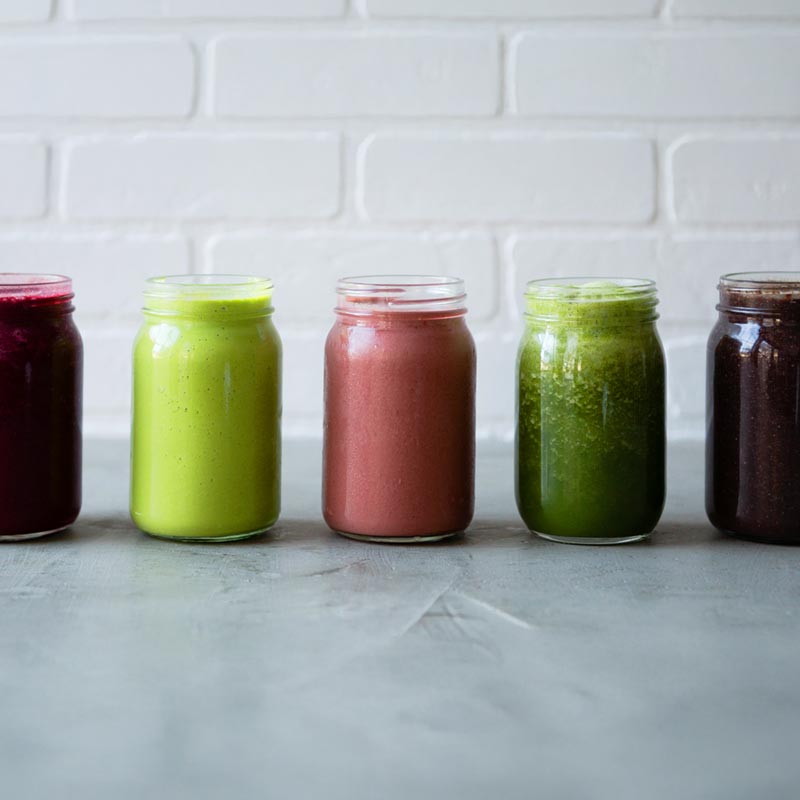
Free 5-Day Smoothie Reset
Get my smoothie recipes to boost energy, fight inflammation and kickstart weight loss—in just 5 minutes a day.
Common Questions
Yes—anti-inflammatory smoothies taste amazing when you balance earthy ingredients (like kale or beets) with naturally sweet fruits (like pineapple, orange, or berries). A little ginger or citrus helps brighten everything up too.
You can have this smoothie every single day, yet feel free to start with just a few times a week to see how your body adjusts. This can be a powerful addition to your routine if you’re working on reducing inflammation.
To mask the taste of beets or leafy greens, add more ginger, pineapple, orange, or berries to help cut the “earthiness.”
Yes, you can make this anti-inflammatory smoothie in advance to save time. Blend it the night before and refrigerate in a sealed jar (drink within 24 hours). Or try freezing meal prep smoothie packs with pre-measured ingredients and dump them into the blender when ready. Another options is to make smoothie cubes (freeze the smoothie in an ice tray) and re-blend with liquid when needed.


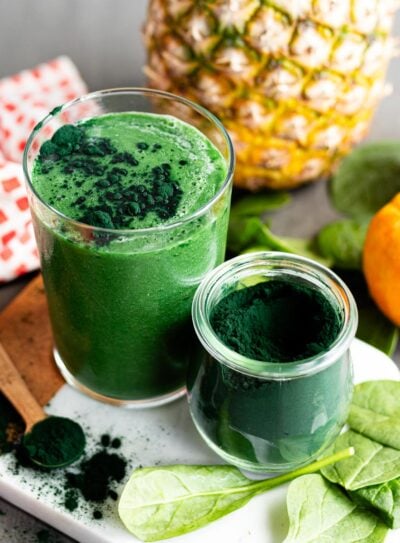
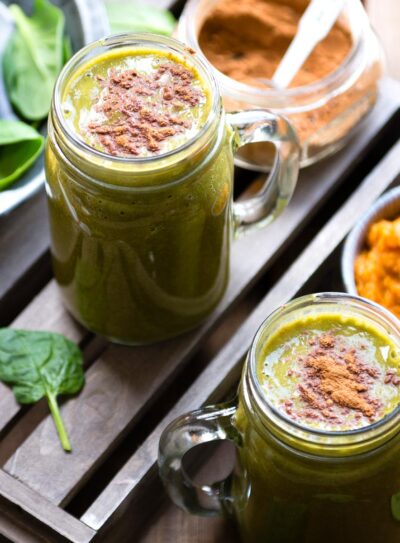

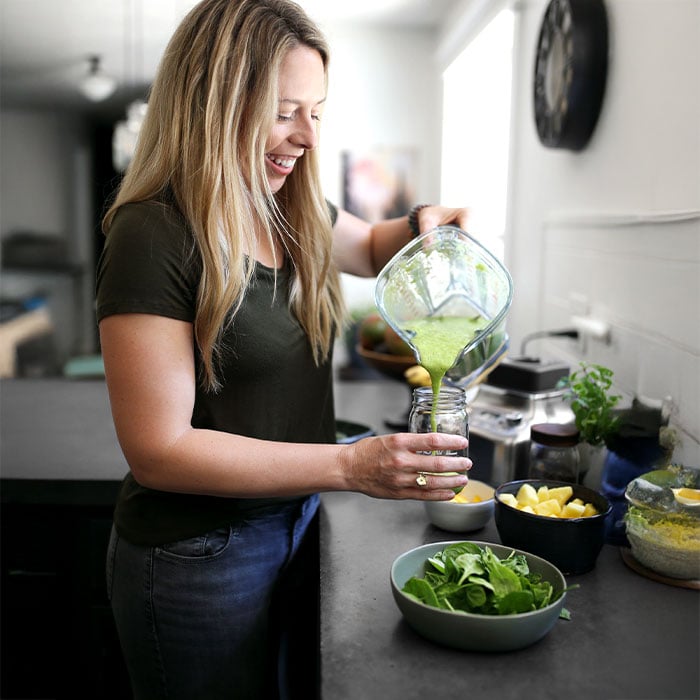
Thank you for this recipe! I am following a lectin-free diet to deal specifically with inflamation, The Plant Paradox plan, as I wrote you about.
I will try it to see if alleviates my pain in my hands and shoulder from arthritis.
I like that you give options, in case I don’t have everything right now and as both of those options are better for me, but this time I will have to try the pineapple and don’t have beets so I will do the mango!
Love your website, have followed you since 2016 I believe and recommend you to everyone I possibly can!
Thank you for coming up with this, per my request!
Glad you like this recipe! I make this smoothie often and I love it. 🙂
hello im pregnant can i take this smoothie ? my inflammation is a lil worst but i see it has 30 sugar is that lot , im trying to be careful with my sugar intake ?
Hi Erika! I would suggest speaking with your healthcare provider and/or nutritionist regarding your diet while pregnant. They know you + your body best! 🙂
Really tasty. Been having this every night before bed.
This is definitely a great one!
Tatse good.. hope it works on the inflamation.. thank you
Muy bueno este articulo los tengo que aser sufro de artritis en una pierna gracias
¡De nada! Lamento saber de tu artritis. Espero que esto ayude.
Love the color of it, looks so refreshing!
Hi Jen, just wondering if I have roasted the beets are they still beneficial in a smoothie? I assume you are using them raw. Thanks,
Donna
Amanda, I know I have a lot of inflammation in my body. I have severe fibromyalgia and have been diagnosed with Type II Diabetes. The above Smoothie looks great but I know it’s too much sugar for me so I see you said to substitute a cup of berries for another cup of greens. 1) will it be too bitter for a newcomer and what should I add or take away for my Fibromyalgia. and 2) is there a list of smoothies for my issues for variety?
Thank you,
Barbara in MD
Hey Barbara,
You can always just add less of the fruit and more of the greens with this recipe instead of adding the berries. You can always add in some dates or honey to naturally sweeten it up a little.
Also, since we are not nutritionist we do not have a specific recommendation for you but I would suggest sticking with these ingredients to fight the inflammation.
Hope that helps!
What blender do you use? I loved this, so tasty but need a large blender for 6 that makes the smooth smooth, I had lots of chunks from the beets and kale. Thanks
Is the coconut oil an anti-inflammatory; was wondering if I can leave that out?
Thank you!
Hey Amanda,
Yes, the coconut oil is an anti-inflammatory so if you can tolerate it I would definitely keep that ingredient.
Hello,
I would like to try this shake, but I have an allergy to pineapple. Do you have any recomendations for a replacement?
Mango is a good replacement for pineapple.
Your style is so unique in comparison to other people I’ve read stuff from.
Thank you for posting when you have the opportunity, Guess I’ll just bookmark this page.
Yay!!! SO happy you love our page, Brad!!! 🙂
Can you use cows milk ?
Hi Villa,
Great question! Dairy can be pretty tough on your digestion, for that reason you won’t find it in our recipes – especially our Anti-Inflammatory Green Smoothie above where we want to show your belly some extra love. Including dairy in your diet – is definitely a personal decision. For us here at Simple Green Smoothies we’ve found that diary doesn’t make our bodies feel great, and if you’re not reaching for organic milk you can find yourself drinking a lot of additives, and lastly – dairy is actually the #1 undiagnosed food allergy. Love dairy and the way it makes you feel? Then go for it – and try adding it to a green smoothie recipe. I’d just suggest skipping our Anti-Inflammatory Green Smoothie as this recipe specifically is designed to heal your gut!
Every time i use spinach in my smoothie i have heart burn
Hi Christine.
Spinach not making your body happy? Swap out spinach for another leafy green you love! Here are a few of our favorites…
https://simplegreensmoothies.com/leafy-greens
Love your website and all the information! However, should there be a concern about the high levels of sugar and carbs that are in the recipes? How does this fit into an overall healthy lifestyle? THANKS
Hi J,
Great question. Each smoothie has 3 cups of fruit in it, and it is recommended that an adult has 1.5 to 2 cups of fruit a day. When you drink 16oz of our green smoothie recipe you will be meeting, or just under your daily intake for fruit. If you feel like that is too much fruit, feel free to do 2 cups of fruit in each smoothie with 3 cups of leafy greens. Hope that helps. 🙂
https://simplegreensmoothies.com/low-sugar-fruits
https://simplegreensmoothies.com/
I tried this one today. It was first time I’ve used Kale. Having just completed the 10 day kickstart. I really enjoyed the kick the ginger gave it and I love fresh beetroot anyway. I had 2 servigs cos my hubby wasn’t keen. So now I’m stuffed like a little piggy 🙂
Hi,i have one question and i wanna know what do you think about it,i heard some rumors that when you blend your food you lose fiber and nutrition from it,personally i dont believe in that especially if you use a high power blender that can blend all food in 30s,i searched on internet and i cant find any studies that confirm that rumors,but i want to know your thoughts about it 🙂
Hi Strahinja,
Great question! We do believe that nutrients begin to “go away” and oxalate, but we don’t believe this happens right away. Our stance is that green smoothies stay good for you for up to two days, as long as they are in a sealed container in the refrigerator.
And while some nutrients may oxalate before you finish your green smoothie. If green smoothies help you add leafy greens + healthy nutrients to your body, we say some nutrients are better than no nutrients at all. #win!
Amanda, I’d like to make a correction to your reply to Strahinja. I believe you meant to say ‘oxidize’ instead of “oxalate” ~calcium oxalate is a crystal found often in urine and is a common cause of urinary/bladder/kidney stones.
Respectfully, Joanna B.
I’ve read that you lose the fiber when you use a juicer to process fruits or vegetables. I think with using a blender, everything stays in place. I’ve never used a juicer. I’ve been told that there is a filter/screen in juicers that catch everything except the liquid.